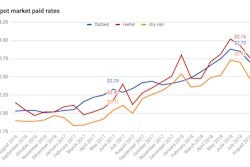Even though August was a relatively strong month for spot market volumes, shippers were moving more freight on rail and through contract carriers last month than they had in previous months. That contributed to the lower spot rates overall in August, a normal trend for this time of year.
 Overall, volumes on the top 100 van lanes in the last week have tracked below where they were at this time last year, but load counts were also elevated last year because of Hurricanes Harvey and Irma. Still, rates are 20 percent higher than they were a year ago. Part of that is because of higher fuel costs, but the lost productivity as a result of the ELD mandate has also played a role.
Overall, volumes on the top 100 van lanes in the last week have tracked below where they were at this time last year, but load counts were also elevated last year because of Hurricanes Harvey and Irma. Still, rates are 20 percent higher than they were a year ago. Part of that is because of higher fuel costs, but the lost productivity as a result of the ELD mandate has also played a role.Hot van markets: The Pacific Northwest moved counter to the national trend in August, and van rates out of Seattle jumped up 5 percent last week. Pricing out of Chicago and Columbus, Ohio, has also largely remained stable during the late-summer slowdown.
Not so hot: The extra competition from intermodal dragged rates down out of Los Angeles. The lane to Chicago fell 14 cents to an average of $1.71 per mile. That’s something of a typical rate for that lane, but it should go up in the fall shipping season.
 Outbound from Chicago, on the other hand, right now delivers plenty of good-rate lane choices for vans. To a certain extent, that’s dampened demand and prices on many inbound lanes. For instance, the average rate on the lane from Atlanta to Chicago was down to $1.58 per mile last week, almost a full dollar per mile below the June peak. One option for doing better for the Chicago-Atlanta roundtrip is to split the return with a trip to Lexington, Ky. That lane averaged $2.03 last week, and the average rate from there back to Chicago was $2.47 per mile. If your schedule can accommodate the extra stops, this trip adds only about 40 miles, not counting deadhead. The better-paying lanes could boost your average rate per loaded mile by 32 cents, from $2.14 to $2.46. That works out to an extra $562 in revenue.
Outbound from Chicago, on the other hand, right now delivers plenty of good-rate lane choices for vans. To a certain extent, that’s dampened demand and prices on many inbound lanes. For instance, the average rate on the lane from Atlanta to Chicago was down to $1.58 per mile last week, almost a full dollar per mile below the June peak. One option for doing better for the Chicago-Atlanta roundtrip is to split the return with a trip to Lexington, Ky. That lane averaged $2.03 last week, and the average rate from there back to Chicago was $2.47 per mile. If your schedule can accommodate the extra stops, this trip adds only about 40 miles, not counting deadhead. The better-paying lanes could boost your average rate per loaded mile by 32 cents, from $2.14 to $2.46. That works out to an extra $562 in revenue. Last week’s reefer trends were largely a matter of latitude, with demand hotter in the northern band of states, while things were pretty quiet down south. This year’s apple crops are looking strong in the Northeast, Midwest and Pacific Northwest, which has led to some extremely tight reefer markets.
Last week’s reefer trends were largely a matter of latitude, with demand hotter in the northern band of states, while things were pretty quiet down south. This year’s apple crops are looking strong in the Northeast, Midwest and Pacific Northwest, which has led to some extremely tight reefer markets.Hot markets: Nuts, onions and potatoes are also contributing to high load-to-truck ratios in Pendleton, Ore., and Spokane, Wash. Outbound reefer rates in Chicago have also risen 12 percent in the past month.
Not so hot: Capacity was loose in the southern half of the country. As a result, reefer rates fell 11 percent out of Miami and Nogales, Ariz., last month. The next biggest decline was out of Dallas, where prices were down 7 percent.









